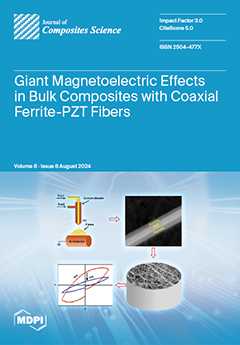In this study, two types of porous C
f/C
m composites were obtained by introducing pyrolytic carbon (PyC) and pyrolytic carbon/furan resin carbon (PyC/FRC). Subsequently, C
f/C
m-SiC-(Zr
xHf
1−x)C composites with different carbon matrices were prepared by
[...] Read more.
In this study, two types of porous C
f/C
m composites were obtained by introducing pyrolytic carbon (PyC) and pyrolytic carbon/furan resin carbon (PyC/FRC). Subsequently, C
f/C
m-SiC-(Zr
xHf
1−x)C composites with different carbon matrices were prepared by introducing SiC and (Zr
xHf
1−x)C matrices into the porous C
f/C
m composites via the reactive melt infiltration method, specifically termed as C
f/PyC-SiC-(Zr
xHf
1−x)C and C
f/PyC/FRC-SiC-(Zr
xHf
1−x)C composites. The microstructures of the porous C
f/C
m and C
f/C
m-SiC-(Zr
xHf
1−x)C composites with different carbon matrices were examined, and a comprehensive analysis was conducted on microstructural evolution and mechanical behaviors of the C
f/C
m-SiC-(Zr
xHf
1−x)C composites. The results indicate that both C
f/C
m-SiC-(Zr
xHf
1−x)C composites underwent similar microstructural evolution processes, differing only in terms of evolution kinetics and final microstructure. Differences in the pore structures of porous C
f/C
m composites, as well as in the reactivities of carbon matrices, were identified as primary influencing factors. Additionally, both C
f/C
m-SiC-(Zr
xHf
1−x)C composites exhibited “pseudo-ductile” fracture characteristics, with flexural strengths of 214.1 ± 8.8 MPa and 149.6 ± 12.2 MPa, respectively. In the C
f/PyC-SiC-(Zr
xHf
1−x)C composite, crack initiation during loading primarily originated from the ceramic matrix, while in the C
f/PyC/FRC-SiC-(Zr
xHf
1−x)C composite, failure initially arose from the residual FRC matrix. Excessive fiber corrosion and the presence of residual low-modulus FRC matrix resulted in lower mechanical performance.
Full article





